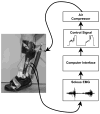A PHYSIOLOGIST'S PERSPECTIVE ON ROBOTIC EXOSKELETONS FOR HUMAN LOCOMOTION
- PMID: 18185840
- PMCID: PMC2185037
- DOI: 10.1142/S0219843607001138
A PHYSIOLOGIST'S PERSPECTIVE ON ROBOTIC EXOSKELETONS FOR HUMAN LOCOMOTION
Abstract
Technological advances in robotic hardware and software have enabled powered exoskeletons to move from science fiction to the real world. The objective of this article is to emphasize two main points for future research. First, the design of future devices could be improved by exploiting biomechanical principles of animal locomotion. Two goals in exoskeleton research could particularly benefit from additional physiological perspective: 1) reduction in the metabolic energy expenditure of the user while wearing the device, and 2) minimization of the power requirements for actuating the exoskeleton. Second, a reciprocal potential exists for robotic exoskeletons to advance our understanding of human locomotor physiology. Experimental data from humans walking and running with robotic exoskeletons could provide important insight into the metabolic cost of locomotion that is impossible to gain with other methods. Given the mutual benefits of collaboration, it is imperative that engineers and physiologists work together in future studies on robotic exoskeletons for human locomotion.
Figures




References
-
- Hughes J. Powered lower limb orthotics in paraplegia. Paraplegia. 1972;9:191–193. - PubMed
-
- Vukobratovic M, Hristic D, Stojiljkovic Z. Development of active anthropomorphic exoskeletons. Med Biol Eng. 1974;12:66–80. - PubMed
-
- Seireg A, Grundman JG. Design of a multitask exoskeletal walking device for paraplegics. In: Ghista DN, editor. Biomechanics of Medical Devices. Marcel Dekker, Inc; New York: 1981. pp. 569–639.
-
- Townsend MA, Lepofsky RJ. Powered walking machine prosthesis for paraplegics. Med Biol Eng. 1976;14:436–444. - PubMed
-
- Vukobratovic M. Humanoid robotics - past, present state, future. Int J Human Robot. 2007 in press.
Grants and funding
LinkOut - more resources
Full Text Sources
Other Literature Sources
